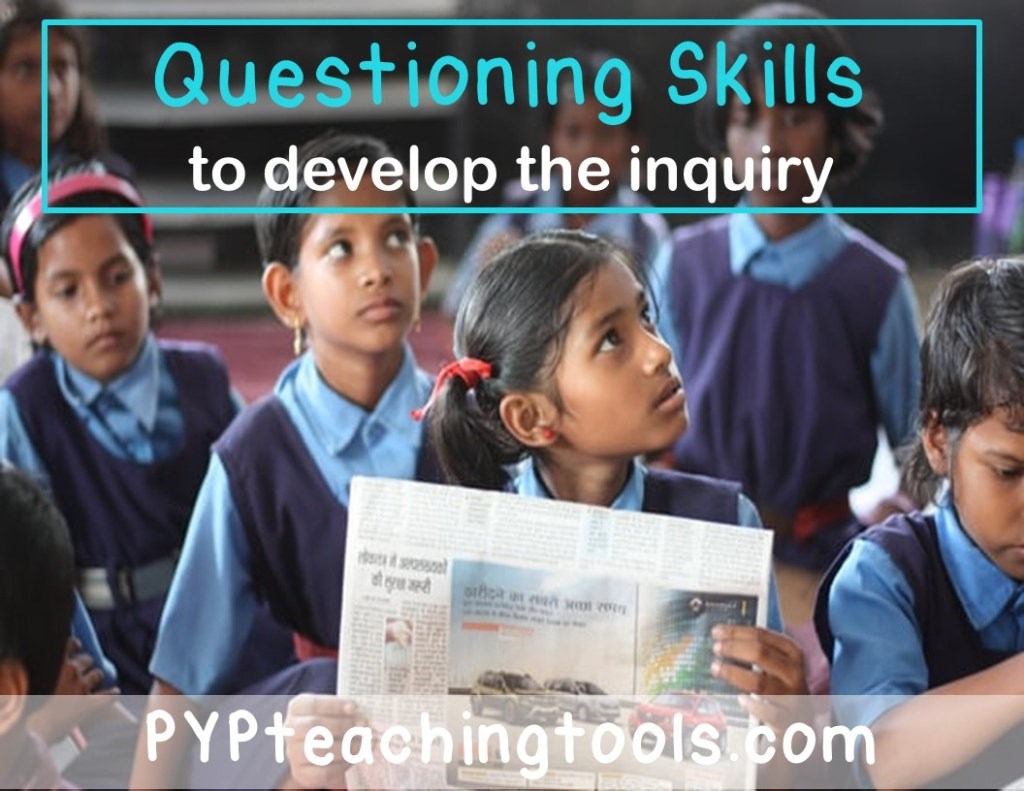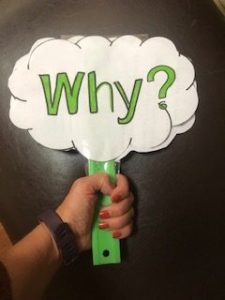Questioning Skills and the IB PYP Inquiry

If we are inquiry teachers, facilitating a student-led inquiry process, then it makes absolute sense that we have to be able to teach the children the art of questioning. Questions are, after all, the beginning of each and every inquiry. Questioning plays an important role in building a true student-led inquiry, beginning with the initial provocation. So, where do we start? Well, allow me to share my experience with you and, hopefully, bring you some practical strategies to take back to your own class of inquirers. If you missed the first part of this discussion about developing the Approaches to Learning Thinking Skills, click here to catch up with how I begin to develop those sub-skills. In this article, I have provided a free video that also offers practical suggestions. But, let’s start by doing.
Using simple thinking routines with the children, as the one below, I would work up to each of those skills: observing, identifying our schema, inferring and questioning; progressively adding to their thinking skills and, more importantly, bringing them an awareness of their metacognitive thinking. For now, we will skip past the first three guiding questions and move straight to “What do you wonder?”
Consider the types of questions that come to mind as you observe the picture below. What we want is to build upon your initial questions, making them higher level and more conceptual, ultimately leading to further questions that will all contribute to a more in-depth investigative inquiry. Read on to find out how I bring this level of thinking into my classroom.
Question Words & Thinking Sticks
I begin with the question words. (who, what, where, why, when) This may sound obvious. But let’s not underestimate the basics. You can use this simple strategy across all ages.


I call these Thinking Sticks. They can be used to teach the question words, especially useful for the youngest children and those learning English but also to guide the children’s thinking so that their focus will only be on question words that begin with those words. “Let’s think ONLY about WHAT questions.” This works well with ANY provocation – For example, if you have an artefact on display, then have the children consider only one type of question at a time. This can then be used to create a simple bank of questions, categorized by the question word.
These Thinking Sticks are great for helping the children to see how each question word can change the direction of the inquiry. Example:
- What is the colour of the sky?

Thinking Skills: Analysing, identifying, sorting and ordering questions from closed to higher level, most open-ended. - How does the sky change colour?
- Why might the sky change colour?
- What if the sky changed colour?
If you have older children who are more able to analyse and sort the questions, then you can have them try to sort the questions in several ways:
- Look slowly: Use the questions to look and then look again at something. Example: Which questions would work for the beginning of the picture book? The end of the picture book?
- First thoughts/Second Thoughts: Look at your first thoughts. Now how might you add to those questions?
- Order the questions from closed to more open ended questions.
- Categorise according to specified/additional concepts: which questions would fit under each concept?

Form & Function: Open and Closed Questions
Both types of questions have their uses. When developing inquirers, we want the children to know the form and function of both. Understanding the difference between closed and open questions will help to bring depth to any inquiry. We want the children to be able to identify their closed questions and then to formulate more open-ended questions. I love to use pictures books for beginning with this skill. You can read more about some amazing books that really help with thinking skills here.

A closed question usually receives a single word answer or a short factual answer. Example: ” Did you like the book?” Your answer will be “Yes” or “No”; “What did you eat?” The answer will be a list of food.
Open questions draw out longer answers. An open question asks for more depth and requires more thought. It often requires investigation. It can also ask for opinion which can lead to debate and discussion. All of this leads to exploration of evidence, searching for meaning and sharing of understanding. Here are some examples:
Open questions are good for:
- Developing an open discussion: “How might the author end the story?”
- Finding out more detail: “What else could we do to make this a success?”
- Finding out the others’ perspectives : “Why do you think the leader did this?”
- Creative thinking: " What IF you got to write the end of the story?"
Closed questions are good for:
- Concluding a discussion or making a decision: “Now we know the details, are we all agreed that this is the correct plan?”
- Assessing understanding: “So, if I add this number of metres to the fence will it change the total area?”
Conceptual Questions
As IB PYP teachers, we want to develop conceptual thinkers. Ultimately, the children will be expected to formulate concept based questions in order to add depth to their inquiry. This involves specific teaching of the IB PYP Key Concepts and of questioning under the umbrella of those concepts.

produces an inquiry that will go narrow and deep, rather than broad and shallow.
Keeping in mind that questioning overlaps with research skills, we want the children to be able to categorise their questions, understanding the related concepts and specified concepts under which their inquiry will largely fall.

I hope that you’re able to find something useful from these strategies that I have used over the years, with children from all around the world.
If you’d like to develop those thinking sub-skills further with your students, take a look at my resource specifically for developing those thinking skills and formulating questions:
Early Years- Grade 2:
- Write & Draw Creative Thinking Skills
- Thinking Skills Through SEE THINK WONDER
- SEE THINK WONDER PLAYDOUGH MATS
- Creative Thinking Skills Task Cards
- Provocation Starter Questions for ANY Inquiry
Grades 3-5
- Developing Thinking Skills Activities & Reference Posters
- ATL Thinking Skills Activities
- Critical Thinking Skills Task Cards
- Creative Thinking Skills Task Cards
- Formulating Questions Learning Experience
- Research Skills Task Cards
Enjoy!

P.S. If you’d like to be sure to receive FREE resources in the future, please add your email here and join my subscribers. I’d love to have you join our community.


